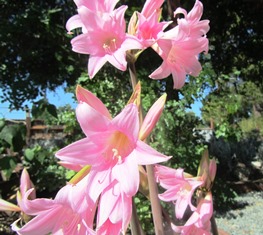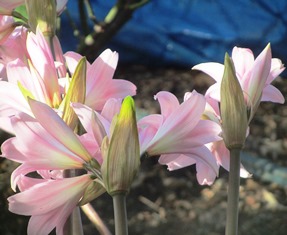The Four-Year Wait for a Bloom
Surprise isn’t the right word for what I felt rounding the corner today. I looked over into our rose garden and the bulbs we planted four years ago finally bloomed, sans the foliage which dried in the California heat a month or two ago.
These beautiful lilies were such a surprise. We saw the long stalks shooting upward with unopened buds on the end and wondered what they were. Then they opened to reveal these dazzling lilies.
They were likely planted in the 1950s or a decade later on the property adjacent to ours. The old man who owned the property behind ours passed away a year or so before we arrived. His daughter gave us the lily bulbs. Alas, she doesn’t seem to remember the flowers (except that there were bulbs) and we don’t know what kind they are either. They look like star lilies, and are born on 3 foot-stalks. There is a very sweet scent emitted from the center of the flower.
I’m having a devil of a time identifying them. There are so many types of lilies, including calla lilies, trumpet lilies, oriental lilies, and day lilies, to name a few. So if you know which cultivar they belong to, please email me at Meeralester1@Gmail.com.
Iris Reward with Sensational Spring Blooms
Few flowers do the double duty of iris in a flower garden. They provide a great background for other flowers and also produce exquisite blooms on their tall stems. Both bearded and beardless iris plants provide textural interest for other perennials, annuals, and herbs, whether in a formal or informal flower bed, along a walkway, or tucked into a corner of a garden.
Iris produce their blooms on stalks that emerge from clumps of stiff, erect, spiked, and pointed green leaves. My iris plants were a gift from the neighbor who owns the property behind the Henny Penny Farmette. The bulbs she gave me had originally been planted by her father and mother, both now deceased. We were thrilled to get the bulbs.
When we planted them on our property, we made sure the soil was amended and we sprinkled in some bone meal and watered well. Then the iris were left alone. We did apply mulch prior to the winter rainy season and because here in the inland valley of the east bay, we can get freezing nighttime temperatures. Those iris plants have rewarded us with spectacular blooms in April each year.
We didn’t know if the bulbs would produce a true blue bloom or some other color, so the anticipation was killing us that first year. Then the buds emerged on tall (roughly three foot stalks) and we could see what was coming. I have to say, the blooms bedazzled us.
Plant height separates the bearded iris into roughly five groups: miniature dwarf, standard dwarf, intermediate, miniature tall, border, and standard tall. Our iris plants fall into the standard tall category. The best time to plant the iris rhizomes is from July to September 15. Set the rhizomes just beneath the soil surface as they do not like being planted too deep. In really cold areas, a thick layer of mulch ensures the rhizome survives alternate freezes and thaws. Lift and divide the rhizomes right after blooming. You can cut the leaves back to six inches for ease in handling the plants.
A note about rhizomes: These thick horizontal stems generate roots from the bottom and the plant’s leaves and flowers emerge from the top. Some plants that grow from rhizomes are bearded irises, calla lilies, and cannas.
 Facebook
Facebook Goodreads
Goodreads LinkedIn
LinkedIn Meera Lester
Meera Lester Twitter
Twitter








